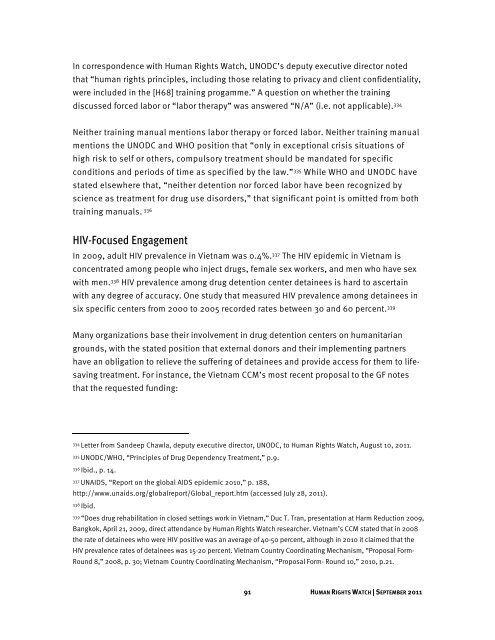The Rehab Archipelago - Human Rights Watch
The Rehab Archipelago - Human Rights Watch
The Rehab Archipelago - Human Rights Watch
You also want an ePaper? Increase the reach of your titles
YUMPU automatically turns print PDFs into web optimized ePapers that Google loves.
In correspondence with <strong>Human</strong> <strong>Rights</strong> <strong>Watch</strong>, UNODC’s deputy executive director noted<br />
that “human rights principles, including those relating to privacy and client confidentiality,<br />
were included in the [H68] training progamme.” A question on whether the training<br />
discussed forced labor or “labor therapy” was answered “N/A” (i.e. not applicable). 334<br />
Neither training manual mentions labor therapy or forced labor. Neither training manual<br />
mentions the UNODC and WHO position that “only in exceptional crisis situations of<br />
high risk to self or others, compulsory treatment should be mandated for specific<br />
conditions and periods of time as specified by the law.” 335 While WHO and UNODC have<br />
stated elsewhere that, “neither detention nor forced labor have been recognized by<br />
science as treatment for drug use disorders,” that significant point is omitted from both<br />
training manuals. 336<br />
HIV-Focused Engagement<br />
In 2009, adult HIV prevalence in Vietnam was 0.4%. 337 <strong>The</strong> HIV epidemic in Vietnam is<br />
concentrated among people who inject drugs, female sex workers, and men who have sex<br />
with men. 338 HIV prevalence among drug detention center detainees is hard to ascertain<br />
with any degree of accuracy. One study that measured HIV prevalence among detainees in<br />
six specific centers from 2000 to 2005 recorded rates between 30 and 60 percent. 339<br />
Many organizations base their involvement in drug detention centers on humanitarian<br />
grounds, with the stated position that external donors and their implementing partners<br />
have an obligation to relieve the suffering of detainees and provide access for them to lifesaving<br />
treatment. For instance, the Vietnam CCM’s most recent proposal to the GF notes<br />
that the requested funding:<br />
334 Letter from Sandeep Chawla, deputy executive director, UNODC, to <strong>Human</strong> <strong>Rights</strong> <strong>Watch</strong>, August 10, 2011.<br />
335 UNODC/WHO, “Principles of Drug Dependency Treatment,” p.9.<br />
336 Ibid., p. 14.<br />
337 UNAIDS, “Report on the global AIDS epidemic 2010,” p. 188,<br />
http://www.unaids.org/globalreport/Global_report.htm (accessed July 28, 2011).<br />
338 Ibid.<br />
339 “Does drug rehabilitation in closed settings work in Vietnam,” Duc T. Tran, presentation at Harm Reduction 2009,<br />
Bangkok, April 21, 2009, direct attendance by <strong>Human</strong> <strong>Rights</strong> <strong>Watch</strong> researcher. Vietnam’s CCM stated that in 2008<br />
the rate of detainees who were HIV positive was an average of 40-50 percent, although in 2010 it claimed that the<br />
HIV prevalence rates of detainees was 15-20 percent. Vietnam Country Coordinating Mechanism, “Proposal Form-<br />
Round 8,” 2008, p. 30; Vietnam Country Coordinating Mechanism, “Proposal Form- Round 10,” 2010, p.21.<br />
91 HUMAN RIGHTS WATCH | SEPTEMBER 2011

















